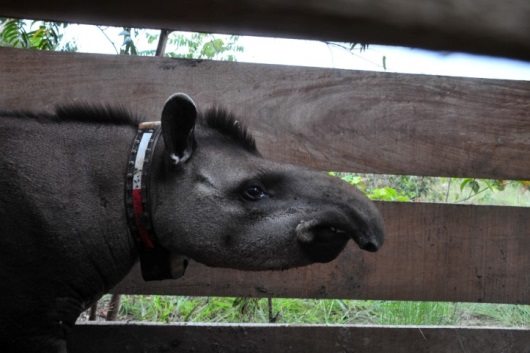Here’s the latest update from our field partners, the Lowland Tapir Conservation Initiative (LTCI) in Brazil. It sounds like the project in the Cerrado is developing well and producing some important and exciting results. Project coordinator, Patricia Medici tells us more:
“At the beginning of the year, we decided to concentrate all our time and energy on getting the Cerrado Tapir Program fully implemented. We’ve been INSANELY BUSY!
“The program has taken off beautifully. In 2015 we only managed to capture two tapirs with just one being old enough to have a radio-collar fit. During our expeditions this year, we managed to capture EIGHT more. Best of all, seven of them were adults and were, therefore, old enough to be radio-collared.
“This takes the total number of tapirs captured in the Cerrado so far to 10; five males and five females, eight adults and two sub-adults. The names of our Cerrado tapirs are: Rafera (sub-adult), Juscelino, Lou, Titi Mahamurda, Roger (sub-adult), Suzanne, Isa, Colombina, Pana and Elis. Many of these tapirs have been named after important supporters for the project from all over the world.

“We are using GPS Iridium technology from Telonics USA – telemetry collars that send data via satellite to my computer at home. We already have tons of data coming in every 2-3 days. This technology is absolutely amazing as it allows us to follow the movements of our tapirs almost in real time. It is fascinating; I have to say I have been completely obsessed with following their movements.
![]() Pati and her team doing some manual radio tracking. Photo credit: The Lowland Tapir Conservation Initiative
Pati and her team doing some manual radio tracking. Photo credit: The Lowland Tapir Conservation Initiative
“We continue to monitor tapir roadkill on seven highways near our study areas in the Cerrado. Since we started monitoring highways in March 2013, we have recorded 110 tapir carcasses, which makes it very clear that roadkill is a truly serious threat to tapirs in the Cerrado. Necropsies – an examination of the body – are carried out right there on the highway with huge trucks flying by, which makes the process even worse. It’s heart-breaking.

The team conducting a necropsy on a roadkill case next to the highway. Photo credit: The Lowland Tapir Conservation Initiative
“Our tapir roadkill data is analyzed regularly and hotspots identified. Our next step is to bring these results to relevant organizations, highway administration departments, and highway concessions among others to start discussions towards mitigating this threat. We are already working with an organisation called WAZE on the development of a map feature that will warn drivers on these highways, particularly truck and bus drivers, about areas of high risk of collision with tapirs in the highways of the State of Mato Grosso do Sul.
“Regarding our tapir health studies in the Cerrado, our preliminary results are showing some very important (and scary) findings. Our first results from toxicological evaluations are showing the presence of heavy metals and pesticides, most probably from sugar cane and soybean plantations. Coincidence or not, we have also found some important macroscopic lesions in liver and kidneys during tapir necropsies. It is well known that pesticides can affect physiological parameters.

Loads of biological samples taken for analysis from necropsies. Photo credit: The Lowland Tapir Conservation Initiative
“We are in the process of mapping sugar cane plantations in the region and holding meetings with environmental conservation departments of sugar cane companies. Some of our monitored tapirs have been found to include sugar cane plantations in their preliminary areas of use and this is an issue we will have to deal with. Sugar cane companies will be an important stakeholder for this project.
 Some tapir dung found in the middle of a fenced sugar cane plantation. Photo credit: The Lowland Tapir Conservation Initiative
Some tapir dung found in the middle of a fenced sugar cane plantation. Photo credit: The Lowland Tapir Conservation Initiative
“In addition, we are getting ready to deal with tapir hunting in the region. We have heard about it happening from several sources. At the moment, we are reviewing literature and consulting with hunting/poaching experts to develop a protocol for the evaluation of tapir hunting in the Cerrado. We will soon be ready to start research which will be most probably based on interviews with members of local communities.”
Keep an eye on our blog for more updates from Pati and the team. In the meantime, why not watch this short video interview we did with Pati when she last visited Chester Zoo.